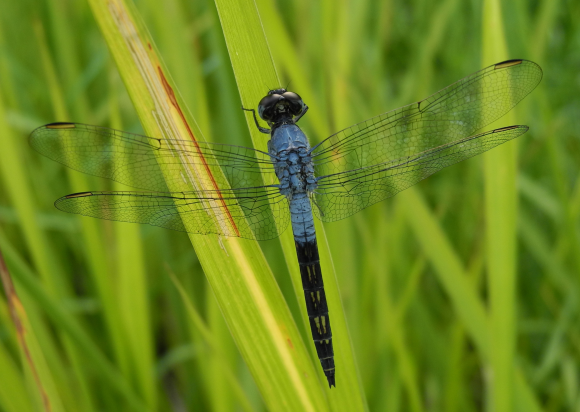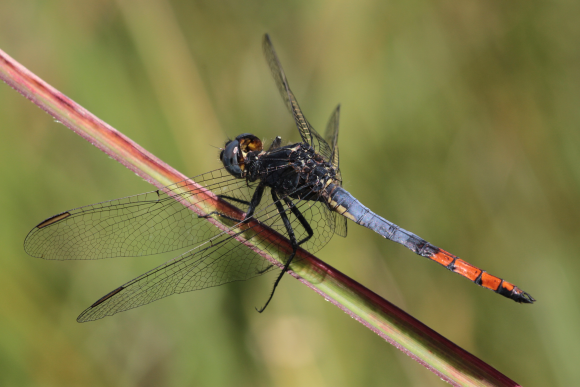Genus Nesciothemis Longfield, 1955
blacktails and peppertails
Synonyms:
- scientific: Limnetothemis Pinhey, 1966
Type species: Orthetrum farinosum Förster, 1898
Introduction
Endemic to Africa and Arabia, with five medium-sized (hindwing 27-35 mm) species. Habits and appearance recall Orthetrum: black-and-yellow when teneral and pruinose with maturity. However, abdominal segments 9-10 never become pruinose and segments 7-8 rarely so, being black or bright red instead. Moreover, mature Orthetrum have bluish eyes, while in the black-tipped species they become dark brown dorsally: thus while mature Orthetrum appear quite evenly bluish, the blackish head and tail of Blacktails contrast with their densely pale pruinose thorax and abdomen base. The status of the ubiquitous N. farinosa and that of its western African counterpart N. pujoli are unresolved: they may represent one species with a cline with least pruinosity in the far west (up to abdominal segment 3) and most (up to base of segment 8) in the south, or two that overlap in central DR Congo. They are widespread in most open habitats, being most common at standing water but frequenting exposed streams too. The similar, but smaller and more pruinose, N. minor only inhabits open streams and rivers. Males of N. farinosa from south-western Africa (e.g. Angola, Botswana) with pruinosity to abdominal segment 7 or even 8 have been confused with N. minor, and may represent another species. The Peppertails N. fitzgeraldi and N. nigeriensis, which could be separated as the genus Limnetothemis as they seem closer to the genus Oxythemis than to the Blacktails, have bluish eyes with maturity and are localised at herbaceous marshes and lakes. [Adapted from Dijkstra & Clausnitzer 2014]
Diagnosis
Male of genus is similar to Orthetrum by (a) size, Hw 22-50 mm; (b) frons flattened, resulting in 2 anterior ‘frontal shields’ demarcated by ridges, ventral ridge is strong and transverse, separating anterior border from remaining frons; (c) frons at most glossy black; (d) wings at most narrowly marked at tip or base; (e) Fw triangle of 1-4 cells, subtriangle of 3-5 cells [1-10]; (f) Fw discoidal field of 3-5 rows, if 2 at base then Fw supratriangle normally with 1-2 cross-veins; (g) 1-3 rows in radial planate (2 rows if Hw has 2 Cux and S7 marking larger); (h) anal loop usually long and boot-shaped with 10 or more cells; (i) 1 Cux in Hw; (j) hamule with prominent lobe than often dwarfs smaller hook; (k) genital lobe large or small, rounded, usually directed away from hamule; (l) if S7 marked, then this mark not or scarcely more prominent than that on S6. However, differs by (1) frontal shields oval rather than triangular; (2) Fw arculus usually proximal to Ax2; (3) Fw supratriangle without cross-veins [0-1]; (4) anterior lamina and genital lobe lower than hamule. [Adapted from Dijkstra & Clausnitzer 2014; this diagnosis not yet verified by author]

Nesciothemis pujoli Pinhey, 1971. Male © Damian Pinguey

Nesciothemis fitzgeraldi Longfield, 1955. Male © Jens Kipping
Map citation: Clausnitzer, V., K.-D.B. Dijkstra, R. Koch, J.-P. Boudot, W.R.T. Darwall, J. Kipping, B. Samraoui, M.J. Samways, J.P. Simaika & F. Suhling, 2012. Focus on African Freshwaters: hotspots of dragonfly diversity and conservation concern. Frontiers in Ecology and the Environment 10: 129-134.
References
- Gambles, R.M. (1966). Two new species of Nesciothemis Longfield, 1955 (Odonata) from Nigeria. Entomologist, 99, 161-173. [PDF file]
- Pinhey, E. (1971). Odonata collected in Republique Centre-Africaine by R. Pujol. Arnoldia Rhodesia, 5, 1- 16. [PDF file]
- Dijkstra, K.-D.B. (2007). The name-bearing types of Odonata held in the Natural History Museum of Zimbabwe, with systematic notes on Afrotropical taxa. Part 1: introduction and Anisoptera. International Journal of Odonatology, 10, 137-170. [PDF file]
- Dijkstra, K.-D.B, and Clausnitzer, V. (2014). The Dragonflies and Damselflies of Eastern Africa: handbook for all Odonata from Sudan to Zimbabwe. Studies in Afrotropical Zoology, 298, 1-264.
- Longfield, C. (1931). A list of the Odonata of British Somaliland and a description of a new species of the genus Enallagma. Entomologist, 64, 274-278. [PDF file]
- Pinhey, E.C.G. (1961). Dragonflies (Odonata) of Central Africa. Occasional Papers Rhodes-Livingstone Museum, 14, 1-97. [PDF file]
- Longfield, C. (1955). The Odonata of N. Angola. Part I. Publicacoes culturais Companhia Diamantes Angola, 27, 11-63. [PDF file]
Citation: Dijkstra, K.-D.B (editor). African Dragonflies and Damselflies Online. http://addo.adu.org.za/ [2024-04-19].

